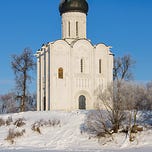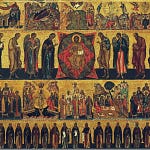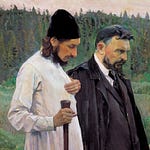Today, the Church celebrates a feast which is as dear to many Slavic Orthodox Christians, especially in the historical lands of the Rus, as it is mysterious to historians. The story about the origins of this feast is found in the description of the vision that Saint Andrew the Fool and Epiphanius, his disciple, were granted during a vigil in the church in Blachernae; but this story does not contain enough historical details to develop a historiography of the feast with any precision. There are several versions of how this feast came to be celebrated, but there is very little evidence to support any one of those theories definitively. One of the theories that seems to have the most scholarly support proposes that the feast was initially unknown in Byzantium, and was first introduced by Prince Andrew of Vladimir-Suzdal in the 12th century. The Slavonic liturgical service for this feast as well as a beautiful white stone church built in its honor near Vladimir both date to the 12th century.
(This 866-year-old church is not the oldest still standing in Russia. Saint Sofia cathedral in Novgorod, for example, was completed in 1050. It was used for divine services until the Communist Revolution of 1917. After the fall of the Soviet Union in 1991, Saint Sofia church was re-consecrated, and divine services are again held in this holy temple that is now 974 years old.)
The Greek service for the Feast of the Protection of the Mother of God on October 1 was not composed until the 19th century. A second service to be celebrated on a separate day, October 28, was composed in the 20th century. There are also no known Byzantine icons of this feast; the oldest known image is in Novgorod and dates to the 13th century. And yet, according to the 10th-century Life of Saint Andrew the Fool and the 12th-century Rus liturgical service, the event took place in Blachernae, a suburb of Constantinople.
The precise dating of the event that gave rise to the liturgical celebration is not easy to perform due to the lack of historical details as well as inconsistencies in various extant records, of which there are over a hundred. The oldest surviving fragment dates back to the second half of the tenth century, but it states that Saint Andrew, one of the two people who saw the apparition of the Most Holy Theotokos, lived in the fifth century. The most common scholarly dating of Saint Andrew’s life, however, is to the second half of the ninth-first half of the tenth centuries. This means that the event described in his hagiography took place sometime in the beginning of the tenth century. Another helpful detail is that the vigil took place during a threat to Constantinople from enemies. Unfortunately, those were plentiful, but specific ones can be identified during the lifetime of Saint Andrew. If the date of the beginning of the tenth century is to be accepted as approximately accurate, then the following image of the event could be reconstructed.
Listen to this episode with a 7-day free trial
Subscribe to Phroneo to listen to this post and get 7 days of free access to the full post archives.













